Narrative: Telling a Story
Looking at visual images, particularly narrative images, helps us to understand what the artist is telling us. A narrative visual image tells us a story using figures within a particular setting – interior or exterior Objects, within the image’s particular setting, allow the viewer to piece together a story – as if piecing together a puzzle. Any prior knowledge, or background information, completes the puzzle and allows for a more comprehensive understanding of the visual narrative.
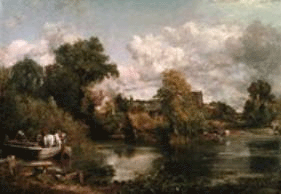
John Constable
The White Horse, 1819
The Frick Collection: New York City
How Does the Artist Tell a Story?
Objectively describing the visual elements and physical activities within the picture frame will help you to begin your search.
Some questions to ask:
What is the focus (or focal point) of the composition? When I look at this painting, what do I see?
Describe what is happening in the image. What is going on?
Describe the setting. Identify the time period. What accessories help to identify the place?
Look to the details:
Natural or staged setting
Interior or exterior environment
Urban or suburban surroundings
Industrial or agricultural indication
What role does the landscape play with regards to the image? What role do the figures play within the landscape? (Do the figure(s) or the landscape dominate?)
How does the foreground/background influence the figures?
What time of day, year, etc. does the action take place in? What atmospheric conditions or forces of nature are apparent?
Describe the figures: singularly or in a group.
Look to the details:
Positioning, activity (what are they doing, where are they placed?)
Physical countenance (body type, weight)
Facial expressions (do they show emotion?)
Clothing (what are they wearing, social status indicated?)
Accessories, objects, props (what is the placement, symbolism?)
Interpersonal relationships (what, and with whom, are they doing?)
Lifestyle (any indication?)
What is the source of light?
Look to the details:
How does the use of light/dark add to the understanding of the image?
What is the position of the viewer? Does the position add to the visual impact of the composition?
Are there any message or moral overtones that the artist is trying to convey?
|
Image Example
|
Artistic Manifestations
|
Artists
|
Artistic Representations
|
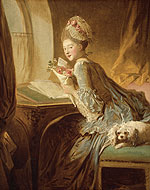 Jean-Honore Fragonard
|
|
|
Portraits (single, group, including backgrounds
Narratives, social statements, satire |

|
|
|
Portraits- single, group. including backgrounds
Narratives - historical, genre Historical metaphors - classical reference |
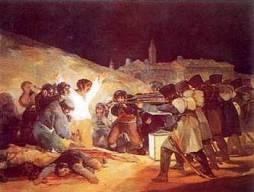
Francisco Goya
|
|
|
Portraits - single, group; including settings and backgrounds
Narrative - literary, historical Landscape -objective, subjective and sublime Architecture -Gothic Revival |
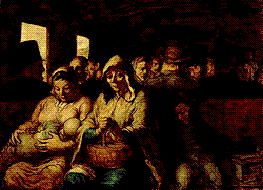
|
Direct observations of society and nature
Development of political and social satire Social and political cartoons and caricatures Social observations,emphasis on class distinctions Natural atmospheres |
France:
|
Portraits - single, group, including settings and backgrounds
Animals - settings, with and without people Narrative - objective, subjective, satire, literary Landscape - as a subject, as a background |
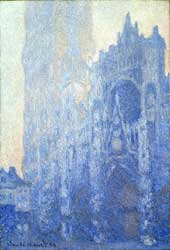
|
|
Artists: France Edouard Manet (1832-1883) Edgar Degas (1834-1917) Berthe Morisot (1841-1895) Claude Monet (1840-1926) Auguste Renoir (1841-1919) Auguste Rodin (1840-1917) |
Artistic Representations: Portraits (single, group; exterior and interior backgrounds) Landscape (as a subject) Narrative (genre, leisure, entertainment) |
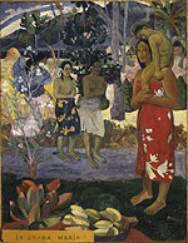
|
Artistic Manifestations: Diverse individual characteristics, yet influenced by Impressionist artists Color theories examined Bright colors; visible distinct brushwork Color separations Clearly defined edges Two manifestations: Formal structure and values: composition paramount Cezanne, Seurat Emotional Content Van Gogh, Gauguin Influence of Japonism |
Artists: France Henri de Toulouse Lautrec (1864-1901) Paul Cezanne (1839-1906) Paul Gauguin (1848-1903) George Seurat (1851-1891) Vincent Van Gogh (1853-1890) |
Artistic Representations: Portraits (self, individual, group) Figure Studies (formal structure vs. emotional content) Still lifes Narratives (religious, metaphors) |
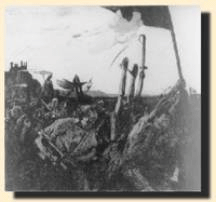
Kathe Kollwitz The Uprising, 1899 |
Artistic Manifestations: Expressive and emotional possibilities of color Introduction of Freudian theory Symbolist content: Social consciousness of realism Internal world of imagination Irrational aspects of the human mind Subject matter: Literature Myths Allegory Dreams Spirituality Haunting, stark imagery |
Artists: France: Henri Rousseau (1844-1910) Edvard Munch 1863-1883) (born Norway) Germany: Kathe Kollwitz (1867-1945) Emil Nolde (1867-1956) Ernst Kirchner (1880-1938) Max Beckman (1884-1950) George Grosz (1893-1959) Austria: Gustave Klimt (1862-1918) |
Artistic Representations: Portrait (self, group) Psychological content Backgrounds Figures (narrative, decorative) |
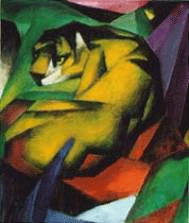
Franz Marc Der Tiger, 1914 Lenbachhaus; Munich, Germany |
Artistic Manifestations: Bright, non-naturalistic, and often unusually vivid colors Strong use of pictorial space, pictorial movement Forms built from color and/or pattern Emotional content |
Artists: France: Henri Matisse (1869-1954) Georges Rouault (1871-1958) Maurice de Vlaminck (1876-1958) Andre Derain (1880-1954) Germany: Franz Marc (1880-1916) |
Artistic Representations:
Figures Landscapes Animals |
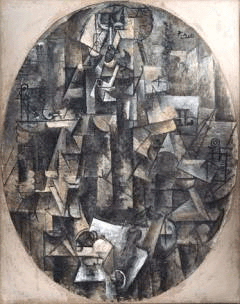 Pablo Picasso Man With a Pipe, 1911 Kimball Art Museum; Fort Worth, Texas |
Artistic Manifestations: Objective Radical approach to space, spatial organization Radical break from reality: Abstraction Fragmentation Distortion Simplification Asymmetry Simultaneous views and directions. No single point of view Bold strokes of color or monochromatic schemes |
Artists: France: Jacques Villon (1875-1963) Pablo Picasso (1880-1973) Georges Braques (1881-1963) Fernand Leger (1881-1955) |
Artistic Representations: Figures Still lifes |
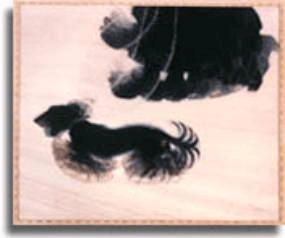
Giacomo Balla Dynamism of a Dog on a Leash, 1912 Jewish Museum; New York City |
Artistic Manifestations: Dynamism, strong compositions Dynamic energy Speed, travel Technology Machines Strong color Break with academic traditions |
Artists: Italy: Giacomo Balla (1871-1958) Filippo Marinetti (1876-1944) Umberto Boccioni (1882-1916) Gino Severini (1883-1966) |
Artistic Representations: People (usually single) Citylife Sports Aeropaintings (depicting movement) Text (words) in art |
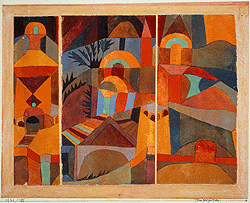
Paul Klee Temple Gardens, 1920 Metropolitan Museum of Art; New York City |
Artistic Manifestations: Correlation between creative design and modern industry and science Smooth, tensile forms combined with strong colors (ex. tubular steel furniture) Integrated expressionist styles with design and architecture Materials: steel, concrete, chrome, glass Varied Fine and Technical artists, architects: Advertising, stage, photography, typography, furniture, architecture |
Artists: (most emigrated after the Nazis closed the Bauhaus in 1933) Germany Lyonel Feininger (1871 – 1956) Walter Gropius (1883 – 1969) Ludwig Mies van der Rohe (1886 – 1969) Josef Albers (1888 – 1976) Switzerland Paul Klee (1879 – 1940) |
Artistic Representations: Abstract imagery Advertising, typography Industrial design: furniture, house-wares Architecture |
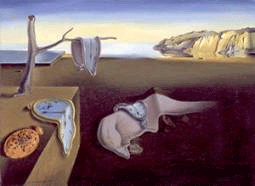
Salvador Dali Persistence of Memory, 1931 Metropolitan Museum of Art; New York City |
Artistic Manifestations: Symbolism, personal imagery Alternative to formal theories of Cubism Emphasis on positive expression Influenced by theories of Sigmund Freud Reunited ‘conscious and unconscious’ realms of experience ‘Absolute Reality:’ the worlds of dream and fantasy joined to the everyday rational world in an “absolute reality, a surreality” |
Artists: France Marc Chagall (1887 – 1985) Marcel Duchamps (1887 – 1968) Max Ernst ( 1891 – 1976) Yves Tanguy (1900 – 1955) Spain Joan Miro (193 – 1983) Salvador Dali ( 1904 – 1989) Belgium Rene Magritte (1898 – 1967) Italy Giorgio de Chirico (1888 – 1978) |
Artistic Representations: Spontaneous imagery, free association Automatism Fantasy Confusion |